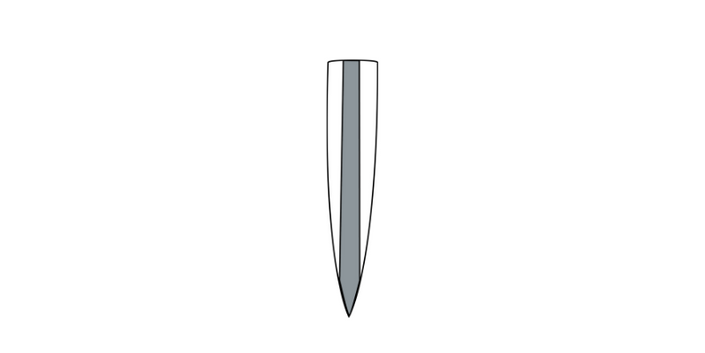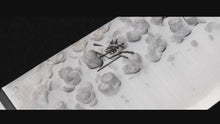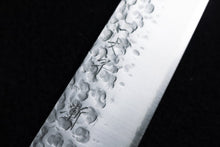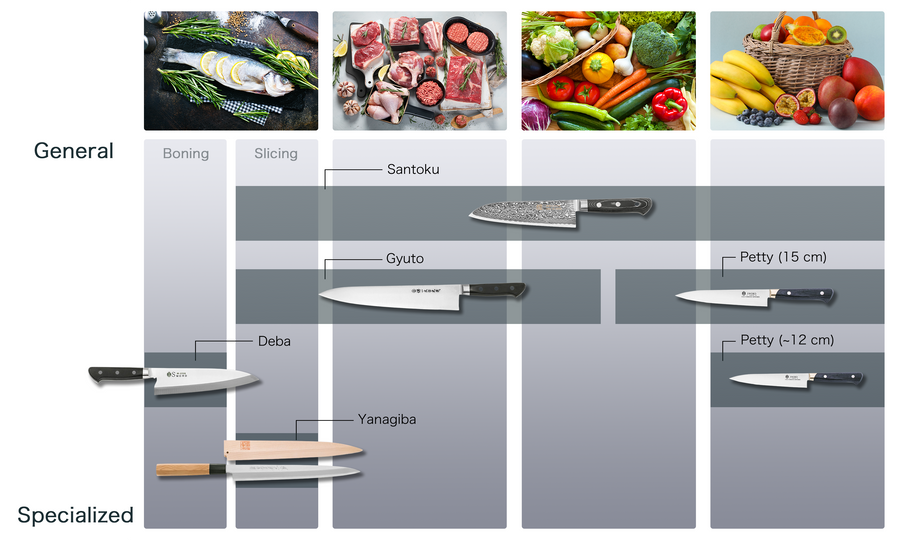
Serie Zen
Nuestro Zen utiliza un tsuchime (martillado) en la hoja, que recuerda a las gotas de agua golpeando la superficie de un río. Con ello se pretende crear una viva imagen de relajación e inculcar la idea de cocinar a tu ritmo de forma relajada.
El Zen se ha creado con un filo de hoja muy cuidado. Con una empuñadura de madera contrachapada de estilo occidental y un equilibrio con el que muchos clientes de ultramar están familiarizados, Zen como su nombre indica, cortan suavemente los ingredientes casi como el agua que fluye en una hendidura. Un filo secundario de alta calidad pero delicado que no necesita afilarse con frecuencia, combinado con una hoja duradera en forma de almeja, permite obtener un cuchillo que le servirá durante muchos años.
Recomendamos encarecidamente este cuchillo en Sakai Ichimonji Mitsuhideun fabricante de cuchillos que lleva más de 70 años apoyando a Osaka desde Doguyasuji.
| Product number | Actual Blade Length (mm) | Full Length (mm) | Total Weight (g) |
|---|---|---|---|
| 2zc-180 | 180 | 310 | 150 |
| 2zc-210 | 210 | 340 | 165 |
| Blade | Material Name | Handle |
|---|---|---|
|
Doble filo |
VG-10 | Mango de madera contrachapada comprimida con borde |

Gyuto
Gyuto significa literalmente "cuchillo de carne". Los japoneses no consumían carne de vaca hasta que empezaron a modernizarse con la creciente influencia occidental a finales del siglo XIX. En aquella época, cuando los japoneses pensaban en la comida occidental, pensaban en gigantescos trozos de ternera cortados y asados a la parrilla o guisados, y así nació el "Gyuto". En hoy día es el cuchillo más común en los hogares japoneses, con también la mayor variedad de aceros, longitudes de hoja y materiales de mango disponibles.

VG-10
La adición de cobalto al acero inoxidable VG-1 aumenta la resistencia al desgaste y la durabilidad. Los cuchillos VG-10 también son fáciles de procesar, lo que los convierte en cuchillos muy versátiles.
Acero Inoxidable
El VG-10 es uno de los aceros inoxidables más utilizados en los cuchillos de cocina de hoy en día y se fabrica a partir de materias primas cuidadosamente seleccionadas y de gran pureza con buena maquinabilidad. El VG-10 es duro y resistente a la vez que fácil de reafilar. Esta combinación de factores confiere al VG-10 una gran ventaja sobre otros aceros de su clase.

Compressed Wood
This handle is made of a durable, compressed plywood, with a flange attached to improve balance. It's known for being very hygiene-friendly because water cannot easily get into the core wedged between the handle.

Revestido/Forrado
Los cuchillos revestidos se fabrican con una lámina de acero que tiene un núcleo de acero duro dentro de dos capas de hierro blando. Después se le da forma, se endurece y se pule. Este método se utiliza a menudo para los cuchillos centrados en el rendimiento de costes, ya que son más fáciles de eliminar las distorsiones de forma y proceso.

Optional Engraving
Optional Engraving Service
Sakai Ichimonji provides complimentary engraving using either Japanese Kanji or English Alphabet. Please specify your preference. For details, please visit here
A knife store that has supported the history of knives and food culture in Japan.
Han pasado más de 600 años desde el nacimiento de la fabricación de espadas en la región de Sakai, en Japón. Sakai Ichimonji Mitsuhide's y sus artesanos continúan construyendo sobre ese legado produciendo las mejores hojas de Japón.
Aquí es donde nació la cultura de completar un plato de sashimi por "simplemente cortandolo" y la cultura de expresar el afilado como "sabor".
Llevamos 70 años conectando el espíritu de los artesanos de Sakai con la pasión de los chefs del distrito comercial de equipamiento de cocina de Osaka, conocido como la cocina de Japón.
Estamos muy contentos de que nuestros cuchillos puedan ser utilizados por personas en todo el mundo.
Precauciones
Después de uso, elimine cualquier resto de suciedad y límpiela a fondo con un paño seco para eliminar la humedad. Este producto no es apto para alimentos congelados.Este producto está hecho a mano, por lo que cada pieza será diferente. Utilice el peso y la longitud indicados como guía. Cada material es natural y puede variar de color. Tenemos mucho cuidado con nuestro inventario, pero en el improbable caso de que estemos fuera de stock, nos pondremos en contacto con usted por correo electrónico para hacerle saber.








































